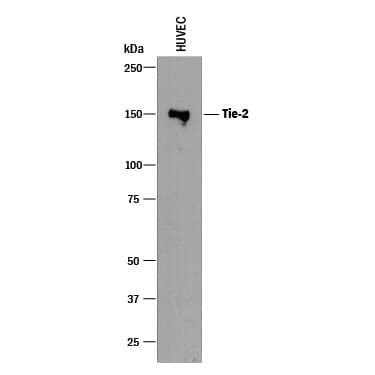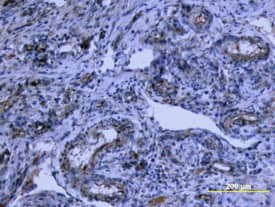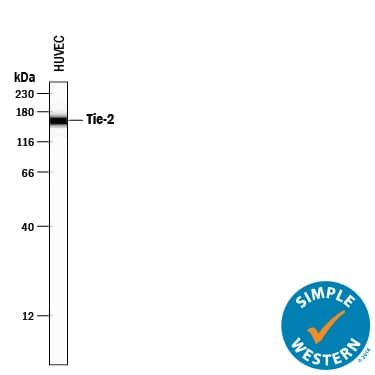Human Tie-2 Antibody
R&D Systems, part of Bio-Techne | Catalog # AF313


Key Product Details
Species Reactivity
Validated:
Cited:
Applications
Validated:
Cited:
Label
Antibody Source
Product Specifications
Immunogen
Ala23-Lys745
Accession # Q02763
Specificity
Clonality
Host
Isotype
Endotoxin Level
Scientific Data Images for Human Tie-2 Antibody
Detection of Human Tie‑2 by Western Blot.
Western blot shows lysate of HUVEC human umbilical vein endothelial cells. PVDF membrane was probed with 1 µg/mL of Goat Anti-Human Tie-2 Antigen Affinity-purified Polyclonal Antibody (Catalog # AF313) followed by HRP-conjugated Anti-Goat IgG Secondary Antibody (HAF017). A specific band was detected for Tie-2 at approximately 150 kDa (as indicated). This experiment was conducted under reducing conditions and using Immunoblot Buffer Group 1.Tie‑2 in Human Placenta.
Tie-2 was detected in immersion fixed paraffin-embedded sections of human placenta using Goat Anti-Human Tie-2 Antigen Affinity-purified Polyclonal Antibody (Catalog # AF313) at 10 µg/mL overnight at 4 °C. Tissue was stained using the Anti-Goat HRP-DAB Cell & Tissue Staining Kit (brown; CTS008) and counterstained with hematoxylin (blue). View our protocol for Chromogenic IHC Staining of Paraffin-embedded Tissue Sections.Detection of Human Tie‑2 by Simple WesternTM.
Simple Western lane view shows lysates of HUVEC human umbilical vein endothelial cells, loaded at 0.2 mg/mL. A specific band was detected for Tie-2 at approximately 161 kDa (as indicated) using 10 µg/mL of Goat Anti-Human Tie-2 Antigen Affinity-purified Polyclonal Antibody (Catalog # AF313) followed by 1:50 dilution of HRP-conjugated Anti-Goat IgG Secondary Antibody (HAF109). This experiment was conducted under reducing conditions and using the 12-230 kDa separation system.Applications for Human Tie-2 Antibody
Blockade of Receptor-ligand Interaction
Immunohistochemistry
Sample: Immersion fixed paraffin-embedded sections of human placenta
Simple Western
Sample: HUVEC human umbilical vein endothelial cells
Western Blot
Sample: HUVEC human umbilical vein endothelial cells
Reviewed Applications
Read 2 reviews rated 3.5 using AF313 in the following applications:
Formulation, Preparation, and Storage
Purification
Reconstitution
Formulation
*Small pack size (-SP) is supplied either lyophilized or as a 0.2 µm filtered solution in PBS.
Shipping
Stability & Storage
- 12 months from date of receipt, -20 to -70 °C as supplied.
- 1 month, 2 to 8 °C under sterile conditions after reconstitution.
- 6 months, -20 to -70 °C under sterile conditions after reconstitution.
Background: Tie-2
Tie-1/Tie (tyrosine kinase with Ig and EGF homology domains 1) and Tie-2/Tek comprise a receptor tyrosine kinase (RTK) subfamily with unique structural characteristics: two immunoglobulin-like domains flanking three epidermal growth factor (EGF)-like domains and followed by three fibronectin type III-like repeats in the extracellular region and a split tyrosine kinase domain in the cytoplasmic region. These receptors are expressed primarily on endothelial and hematopoietic progenitor cells and play critical roles in angiogenesis, vasculogenesis and hematopoiesis.
Human Tie-2 cDNA encodes a 1124 amino acid (aa) residue precursor protein with an 18 residue putative signal peptide, a 727 residue extracellular domain and a 354 residue cytoplasmic domain. Two ligands, angiopoietin-1 (Ang-1) and angiopoietin-2 (Ang-2), which bind Tie-2 with high-affinity have been identified. Ang-2 has been reported to act as an antagonist for Ang-1. Mice engineered to overexpress Ang-2 or to lack Ang-1 or Tie-2 display similar angiogenesis defects.
References
- Partanen, J. and D.J. Dumont (1999) Curr. Top. Microbiol. Immunol. 237:159.
- Takakura, N. et al. (1998) Immunity 9:677.
- Procopio, W. et al. (1999) J. Biol. Chem. 274:30196.
Long Name
Alternate Names
Entrez Gene IDs
Gene Symbol
UniProt
Additional Tie-2 Products
Product Documents for Human Tie-2 Antibody
Product Specific Notices for Human Tie-2 Antibody
For research use only

